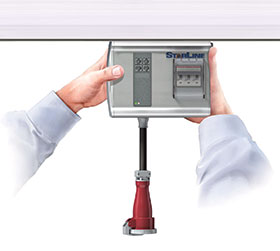
With the world becoming increasingly dependent on the internet, the need for additional bandwidth is steadily escalating. This requires larger facilities and infrastructure, which demand more power and a dependable electricity supply. To address these challenges in the most efficient way, it is important that decision makers take advantage of the most advanced technology available rather than facing the needs of the future with solutions of the past.
Data centres need to be able to accommodate more servers, and facilities managers need to address the constant need for additional capacity quickly. In order to support the extra elements required, worldwide IT spending on servers, power, cooling, and management has increased significantly over the last decade.
In addition to the increase in costs at data centres, the need for higher voltage power poses additional challenges. To accommodate this need, the installation of overhead power distribution systems in data centres has proved an effective way to provide increasing amperage.
The way it was
Power and cooling are two critical requirements of a data centre. Previously raised floors or concrete tiles installed onto a steel grid above a slab floor were deployed for cooling purposes. The perforated tiles that made up the floor allowed cool air to flow out of the passage below and onto the server racks. However, this underfloor area also housed cables that supplied power to the racks. As the facility expanded, more server racks were installed, which required more power, in turn creating more cables under the raised floor, ultimately restricting the flow of cool air.
Higher, sustainable busway power
Overhead power distribution is a scalable and sustainable solution to providing power. Busway systems provide continuous access to power, enabling the data centre facility to always be prepared for future reconfigurations or expansion. Power is accessible at any location with various plug-in units, eliminating the need for panel boards, long runs of conduit and wire, and expensive installation costs for dedicated power outlets.
With an overhead bus system, there is no need to work on live panels or schedule outages to add, move or change outlets. Busway systems eliminate the need to remove and scrap short or undersized cable whips and run longer or larger ones. Therefore, the risk of an unintended power outage is avoided, and racks can be installed or moved without disrupting operations.
Busways are highly sustainable systems and can be used for many years, which means there is less material waste than the traditional cable method. To cope with today’s increasing server densities, an increase in kW power density is also needed, which equates to an increase in cooling requirements. Previously, this required additional power cables under the floor that obstructed air flow and made cooling more difficult. With the safe and energy-efficient overhead busway system for distributing power, this threat is eliminated.
Flexible and scalable
It is sometimes difficult to know the exact electrical design needed at the beginning of a project, and the need to reconfigure electrical outlets and locations increases costs and causes schedule delays. With a scalable overhead busway system, components and power circuits can be added as needed, without unnecessary capital investment and wasted resources. This system also reduces maintenance requirements as there is no need to reconfigure electrical outlet locations and types.

Increased usable space
Overhead busway systems also allow for efficient use of valuable space for IT equipment and server racks. In addition, fewer metres of power cables are required, and power outlets or drops can be located exactly where they are needed.
Monitored power usage
Uptime is critical at data centres, and unplanned power outages must be avoided. It is also important for the facilities manager to accurately monitor the amount of power being used. Premium overhead power distribution systems can incorporate metering units at both the feed and circuit breaker level. These devices capture real-time power and energy measurements, providing the data necessary to make informed decisions, like enabling phase balancing as needed.
Other metering functions include daisy-chain Ethernet to reduce the number of network switch ports, alarm functions and remote communication via an integrated webpage. This allows data centre managers to track power usage intelligently, and plan for future requirements.
Installation and future cost savings
Legrand specialists work closely with data centre teams around the world to design customised overhead power distribution systems that meet their current and future requirements. Compared to installing a raised floor with thousands of cables, overhead busway installation is simple, efficient and flexible.
| Tel: | +27 11 444 7971 |
| Email: | [email protected] |
| www: | www.legrand.co.za |
| Articles: | More information and articles about Legrand |

© Technews Publishing (Pty) Ltd | All Rights Reserved